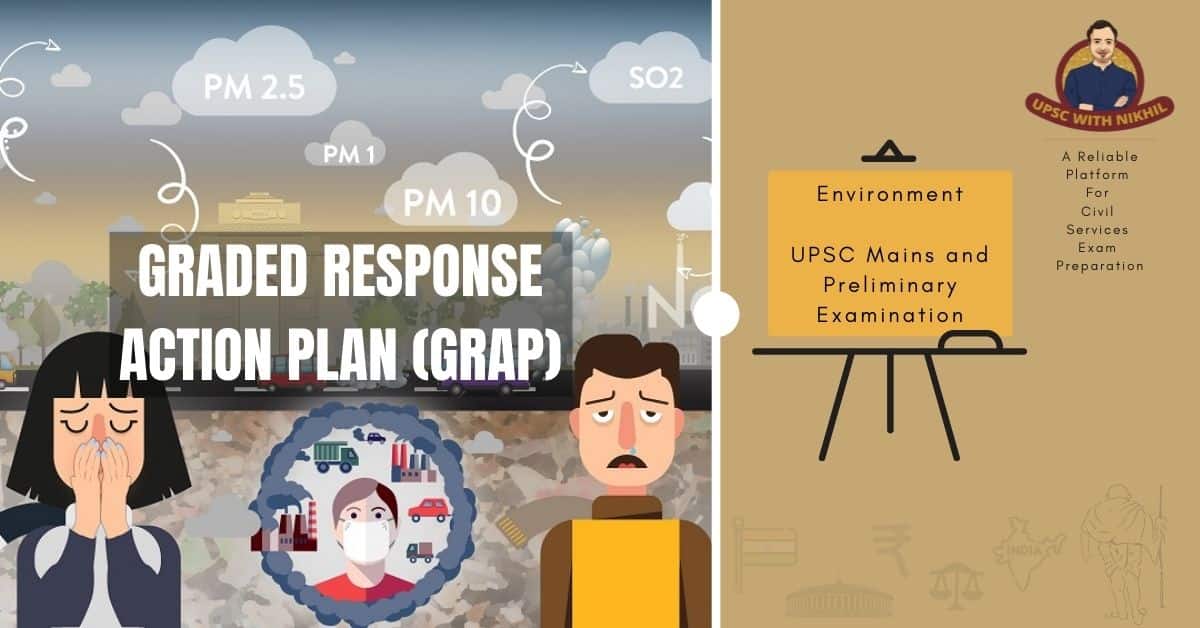Graded Response Action Plan (grap)
• Once the pollution level reaches a certain specified limit, a Graded Response Action Plan is a set of stratified actions that are taken.
• The Environmental Pollution Control Authority (EPCA) had been ordered by the Supreme Court to develop such a plan. This plan was recently announced by the Union Environment Ministry for Delhi and the National Capital Region.
• The plan specifies a number of restrictions. The pollution levels, or more specifically, the Particulate Matter concentrations, are the limits.
• When Particulate Matter concentrations reach a certain level, such as 100 micrograms per cubic meter, several pollution-control measures must be implemented, such as water sprinkling on roads, more frequent road sweeping, and so on.
• When the pollutant concentration reaches a certain level, a ban on firecrackers and other forms of fuel, among other things, may be imposed.
• The Environmental Pollution Control Authority, with the help of a task force, is responsible for determining the particulate matter levels in each state.
• After that, the concentration levels are thoroughly examined. The Environmental Pollution Control Authority orders various departments to begin functioning in order to control these levels if it reaches the specified limit in any state. Prior to the start of the project, each department is given a set of tasks to complete.
• The transportation department, the public works department, and so on are examples of these departments.
• These tasks are supposed to be completed so that pollution levels can be controlled at an early stage. Because it performs its function in stages, it is referred to as a "graded" plan.
• There are separate tasks for different levels of pollution concentration. Pollution control is achieved gradually in this manner. However, it is not the responsibility of any one department. It is a collaborative effort involving several departments. The plan's main goal is to avoid taking drastic pollution control measures all at once and instead respond to the problem gradually.
KEY FACTS
• A Graded Response Action Plan identifies the actions to be taken in response to air quality as measured by PM 2.5 and PM 10 levels in the atmosphere.
• Air quality has been graded as Emergency, Severe, Very Poor, and Moderately Poor. The Environment Pollution Control Authority will be in charge of enforcing it (EPCA).
• Under this plan, emergency measures will be implemented in the NCR if PM2.5 levels exceed 300 micrograms per cubic metre (gm/m3) for two days in a row and PM10 levels exceed 500 (gm/m3).
• To combat air pollution, the plan suggests measures such as an odd-even car rationing scheme and a ban on construction activities.
• During periods of ‘extremely poor' air quality, it suggests banning diesel generators and increasing parking fees by three to four times.
• It also proposes a number of other measures, including the closure of brick kilns, stone crushers, and hot mix plants, as well as the expansion of public transportation and increased frequency of mechanized cleaning and water sprinkling on roads.
• In accordance with sub-section (1) of section 3 of the Environment (Protection) Act, 1986, the Union Government has entrusted the implementation of the Graded Response Action Plan to the EPCA (Environmental Pollution Control Authority) (29 of 1986).
• The Central Pollution Control Board (CPCB) prepared a comprehensive action plan for Delhi, which was submitted to the Supreme Court in December 2016. The plan had been accepted by the court, which had requested that the Union Government notify it.
BS-NORMS
• The Government of India established the Bharat stage emission standards (BSES) to regulate the output of air pollutants from internal combustion engines and spark-ignition engines equipment, including motor vehicles.
• The Central Pollution Control Board, which is part of the Ministry of Environment, Forests, and Climate Change, sets the standards and timeline for implementation.
• In the year 2000, the standards, which were based on European regulations, were first implemented. Since then, more stringent standards have been implemented.
• Following the implementation of the regulations, all new vehicles must comply with the regulations.
1. Bharat Stage (BS) III norms have been in effect across the country since October 2010.
2. Bharat Stage IV emission norms have been in place in 13 major cities since April 2010, and they have been enforced across the country since April 2017.
3. The Indian government announced in 2016 that the country would forego the BS-V standards entirely in favor of BS-VI standards by 2020. The Supreme Court recently issued an order prohibiting the sale and registration of motor vehicles that meet the Bharat Stage-IV emission standard throughout the country beginning April 1, 2020.
DIFFERENCE BETWEEN BS-IV AND THE NEW BS-VI:
• The presence of Sulphur is the primary difference between the existing BS-IV and new BS-VI auto fuel standards.
• The newly introduced fuel is expected to reduce Sulphur emissions by 80%, from 50 parts per million to 10 parts per million. According to analysts, NOx (nitrogen oxide) emissions from diesel cars are expected to drop by nearly 70%, while NOx emissions from petrol cars will drop by 25%.
WHY IS IT IMPORTANT TO UPGRADE THESE NORMS?
• Air pollution can be reduced by upgrading to stricter fuel standards.
• India is a big bet for global automakers because vehicle penetration is still low compared to developed countries. At the same time, cities like Delhi are already being listed as having some of the world's worst air quality.
• Governments can no longer afford to relax on this front, as evidenced by the national capital's recent odd-even car experiment and judicial activism against the registration of large diesel cars.
• India has been lagging behind other developing countries, such as China, which has already upgraded to the equivalent of Euro V emission norms. Poor air quality can be bad for business, as countries like China and Malaysia have discovered. As a result, these reforms have the potential to put India ahead in the race for investments.



